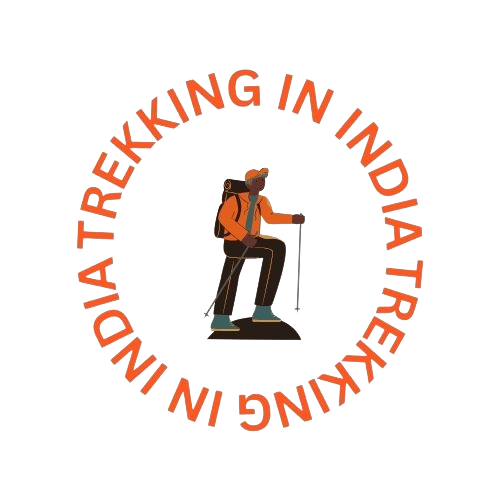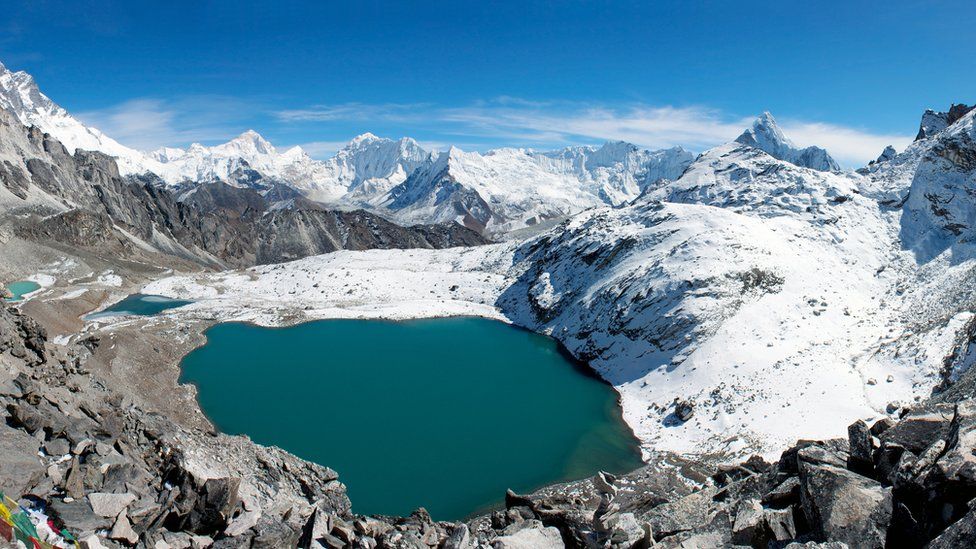Gangotri Glacier
Region : Uttarkashi District, Garhwal, Uttarakhand
Glacier Termination Point : Gaumukh At 4,000m
Altitude Variation : 6,772m To 6,380m
Best Time To Visit : Mid April To May-June & September To November
Gangotri glacier is a well-known glacier in Garhwal Himalayas, situated in Uttarkashi district. The glacier originates at the northern slope of Chaukhamba range of peaks. This is not a single valley glacier, but a combination of several other glaciers that are fed to it and form a huge mass of ice. Bhrigupanth (6,772m), Kirti stambh (6,285), Sumeru Parvat (6,380m) respectively and ratavana bamak, chaturangi bamak and swachand bamak lie on the northeast slope of Srikailash, Man Parvat, Satopanth and an un-named group of peaks.
The glacier lies within a span of 28-kms and terminates at Gaumukh (4,000m). The glacier flows at a gentle slope except for a few ice walls and crevices developed in the upper regions of the glacier where, as in the lower part (above the snout), the glacier is covered by debris, which imparts a muddy appearance to its surface.
The glacier is easily approachable. It is well connected by motorable road upto gangotri temple and from there a 17-km long bridle path follows along the right bank of the Bhagirathi River to Gaumukh, the snout of the glacier.
Dokriani Glacier
Region: Garhwal, Uttarakhand
Local Name: Bamak
Altitude Variation: 5,600m To 6,000m
Best Time to Visit: Throughout Summer And Autumn Season.
Dokriani ‘Bamak’ is a well-developed medium sized glacier of the Bhagirathi basin. The glacier is formed by two cirques, originating at the northern slope of Draupadi Ka Danda and Jaonli Peak, 5,600 m and 6,000 m respectively. The glacier is 5-km long and flows in the northwest direction terminating at an elevation of 3,800m.
The stream originating from the glacier’s melted water is called “Dingad”, which later joins many other snow/ice-melted streams and finally merges into Bhagirathi River near Bukki village. There are several well-developed meadows and proglacial lakes located 2 km below the snout of the glacier. These meadows, lakes and other formations themselves tell their past history and behaviour of the glacier and also provide good camping sites.
The glacier is easily approachable from Uttarkashi. Nearly 56-km from Uttarkashi on the road to Gangotri, Bukki village is 2-km, from the bus terminus situated on the right bank of Bhagirathi River. On way to Dokriani glacier, one has to walk
23-km from the road. After crossing the Bhagirathi river a footpath flows along the steep mountain slopes up to Tela camp. From Tela to Gujjar hut a 12-km. Run along the Dingad stream is a route offered to cross the several up and down ridges, many small and big streams and dense mixed forests of Deodar, Rhododendron, Oak, Pine, etc. provide an atmosphere of perfect peace and tranquility.
Overwhelmed by such heart-touching beauty one crosses the way without difficulties. Gujjar hut (a summer camp of Gujjars with their buffaloes) is located at a height of 3,500m, just 5-km below the Dokriani glacier. Gujjar hut is the gateway of the valley. The valley has a gentle slope with different land features formed by the glacier and surrounded by snow-covered peaks. This place is good for camping and one can walk up to the glacier and adjoining areas and climb the small peaks. Only Gujjar huts and a base camp (near the glacier snout) of Wadia Institute of Himalayan Geology, Dehradun lie on the way.
One visiting the area has to make his own arrangement for food, tents and light warm clothes. The best season to visit is throughout Summer and Autumn. Besides the above two glaciers, Kedar, Rudugaira and Jaonli are some other glaciers which are approachable by the same way.
Bandarpunch Glacier
Region : Garhwal, Uttarakhand
Significance : Important Glacier of The Yamuna River Basin
Altitude Variation : 6,316m To 6,387m
Best Time To Visit : Throughout Summer And Autumn Season.
Bandarpunch is an important glacier of Yamuna river basin. The glacier is 12-km long situated on the northern slopes of Bandarpunch Peak (6,316m), Bandarpunch West (6,102 m) and Khatling peak (6387 m). The glacier is formed by three cirque glaciers and later joins the Yamuna River. It lies on a gentle slope and is bounded by lateral moraines, which indicate the last surface level of the glacier.
The glacier can be approached from Dehradun to Sankri-Saur by bus and from Sankri-Saur to Taluka, 11-km by jeep or light vehicle, then Osla, 14-km. From Osla Ruinsara Tal, located just below the glacier snout, is the best camping site. From Ruinsara one can visit the glacier and its surrounding area.
Khatling Glacier
Region : Garhwal, Uttarakhand
Significance : Important Glacier of The Yamuna River Basin
Altitude Variation : 6,316m To 6,387m
Best Time To Visit : Throughout Summer And Autumn Season.
This lateral glacier situated in Tehri district is the source of river Bhilangna. Snow peaks of the Jogin group, Sphetic Pristwar, Barte Kauter Kirti Stambh and Meru surround the glacier. The moraines on the side of the glaciers look like standing walls of gravel mud.
The trek, which starts, from Ghuttu is easily approachable by motor from Dehradun, Tehri, Mussorie and the Rishikesh railhead. One has to trek about 45–km and pass through remote villages with thick Kharsao forest and wide-open beautiful lush grassy meadows. The entry to the Bhilangna valley provides excellent spots for camping. Tents and adequate provisions need to be arranged in advance from Rishikesh, Tehri and Dehradun.
Chorbari Bamak Glacier
Region : Garhwal, Uttarakhand
Lake Formed By Glacier : Ganghi Sarovar
Altitude Variation : 600m To 3,800m
Best Time To Visit : Throughout Summer And Autumn Season.
The glacier is approachable by road upto Gaurikund via Rudraprayag, Guptkashi and Soneprayag. From Gaurikund, a foot trek runs over the hill slopes upto Kedarnath temple. From Kedarnath temple, there is a 3-km footpath to the glacier snout. Between the rock face and right lateral moraine of the glacier, there is a lake formed by glacier-melted water called “Ganghi – Sarovar”.
Chorbari Bamak glacier is situated in Rudraprayag district of Uttaranchal the glacier is 6-km. Long and originates from the southern slope of Kedar-dome, Bhartekhunta and Kirti Stambh and this hill range is the water divide which separates the gangotri group of glaciers and the Chorbari glacier. Several hanging glaciers and avalanche chutes feed the glacier. The lower part of the glacier is covered by thick debris and bounded by huge deposits of lateral moraines. The glacier starts from its accumulation zone (600m) and terminates at an elevation of 3,800 m, from where a snow/ ice melt stream originates, called “Mandakini” and merges into the Alaknanda River at Rudraprayag.
Doonagiri Glacier
Region : Garhwal, Uttarakhand
Significance : Important Glacier Of Dhauli Ganga System
Altitude Variation : 5,150m To 4,240m
Best Time To Visit : Mid May To Mid October
Doonagiri glacier is one of the important glaciers of Dhauli Ganga system of glaciers where more than 500 glaciers, of different shapes and sizes lie in the deep and narrow valleys. The important glaciers here are: Changbang, Girthi, Hoti and Niti glaciers. Doonagiri glacier is 5.5-km long, extending between an elevation from it head 5,150m to the snout 4,240m, which is the terminal point of the glacier. A stream originating from the glacier merges into Dhauli Ganga near the Juma village.
The glacier is approachable from Juma on the way to Joshimath-Malari Road. 8-km from Juma lies the Doonagiri village. From Doonagiri village a 12-km long foot-trek runs along the Doonagiri stream to reach the glacier snout. Bagini is another glacier in this valley. Doonagiri is the last village in the valley. Near the vicinity of the glacier there is a good place for camping. The best time to visit the place is mid May to mid October.
Tiprabamak Glacier
Region : Garhwal, Uttarakhand
Significance : Longest Glacier Of Bhyundar Ganga Basin
Best Time To Visit : Mid June To Mid October
Tiprabamak (Bamak is the local name for the glacier) is a 6-km long glacier of Bhyundar Ganga basin in the Alaknanda catchment. Nearly 16 glaciers of various sizes and shapes exist in the basin, out of which only Tiprabamak and adjoining Ratanban glaciers are of significance. The melted water discharge of these glaciers emerges from a single ice cave at the snout of the Tiprabamak.
A thick deposit of debris covers the glacier surface and the upper part of the glacier is approachable through Joshimath-Badarinath road upto Govind-Ghat. From Govind-Ghat is a 18-km bridle path, which runs via Bhiundhar village upto Ghangaria. Further 4-km from Ghangaria, the famous valley of flowers is located at base of Kagbhusndi range of peaks. Ghangaria is the only place for staying in this vicinity. The best time to visit the glacier is mid June to mid October.
Satopanth, Bhagirathi-Khark Glacier
Region : 17-km From Badrinath, Chamoli District, Garhwal, Uttarakhand
Altitude Variation : 3,810m To 3,820m
Best Time To Visit : Only In Summer
The Satopanth and Bhagirathi Kharak are important glaciers in upper Alaknanda basin and are a source of the river Alaknanda. These glaciers are located 17-km from the famous temple of Badrinath, in Chamoli district. The Satopanth glacier is possibly derived from two words; ‘Sato’ meaning heaven and ‘Panth’ stands for path or way.
These glaciers originate from the peaks of Chaukhamba and Badrinath range of peaks, which separate them from the Gangotri group of glaciers. These glaciers are 13 and 18 -km long, respectively and terminate at an elevation of 3,810 m and 3,820m, respectively.
These glaciers are approachable from Joshimath in the Chamoli sub-division, by following the Badrinath and Mana (3,128m) motorable road. From Mana the route follows along the course of the Alaknanda river. A water fall (145 m), named Vasudhara, lies on the right bank of the Alaknanda at an elevation of 3,250m. from Vasudhara, 5-km upward the snout of the glaciers open. 2-km down the valley, the left bank of the river is suitable for camping. The glacier can be approached only in summer.
Nanda Devi Group of Glaciers
Region : Garhwal, Uttarakhand
Altitude : 7,108m
Best Time To Visit : Mid April To May-June & September To November
Nanda Devi north and Nanda Devi south are two important glaciers, each with a length of approximately 19-km located in the Rishi Ganga River catchment. These glaciers originate on the southern slope of Nanda Devi peak (7,108 m). Other important glaciers in the vicinity are Trishul, Kurumtoli, Nandakna, Bartoli and Ramani. These glaciers are well developed and are large in size and length. Several melted-water streams originate from these glaciers and form the river Rishi Ganga, which later joins the Dhauli Ganga at Raini, 25-km from Joshimath.
These glaciers are approachable from Joshimath, on the way to Malari road. Lata, about 25-km from Joshimath, is the last roadhead. From Lata, a bridle path follows through a dense forest of Pine, Bhoj and other trees and alpine meadows upto Lata Kharak. From Lata Kharak the route passes through narrow gorges, steep mountain slopes and sometime through snow patches, to reach the glaciers snout.
www.trekkinginindia.net Uttarakhand India based Travel Agent and Tour Organizer offers tours to Garhwal Himalayas Glacier and Kumaon Himalayas Glacier tours in India, we offers complete Glaciers tour package including stay in quality hotels transport and other adventure gears.

